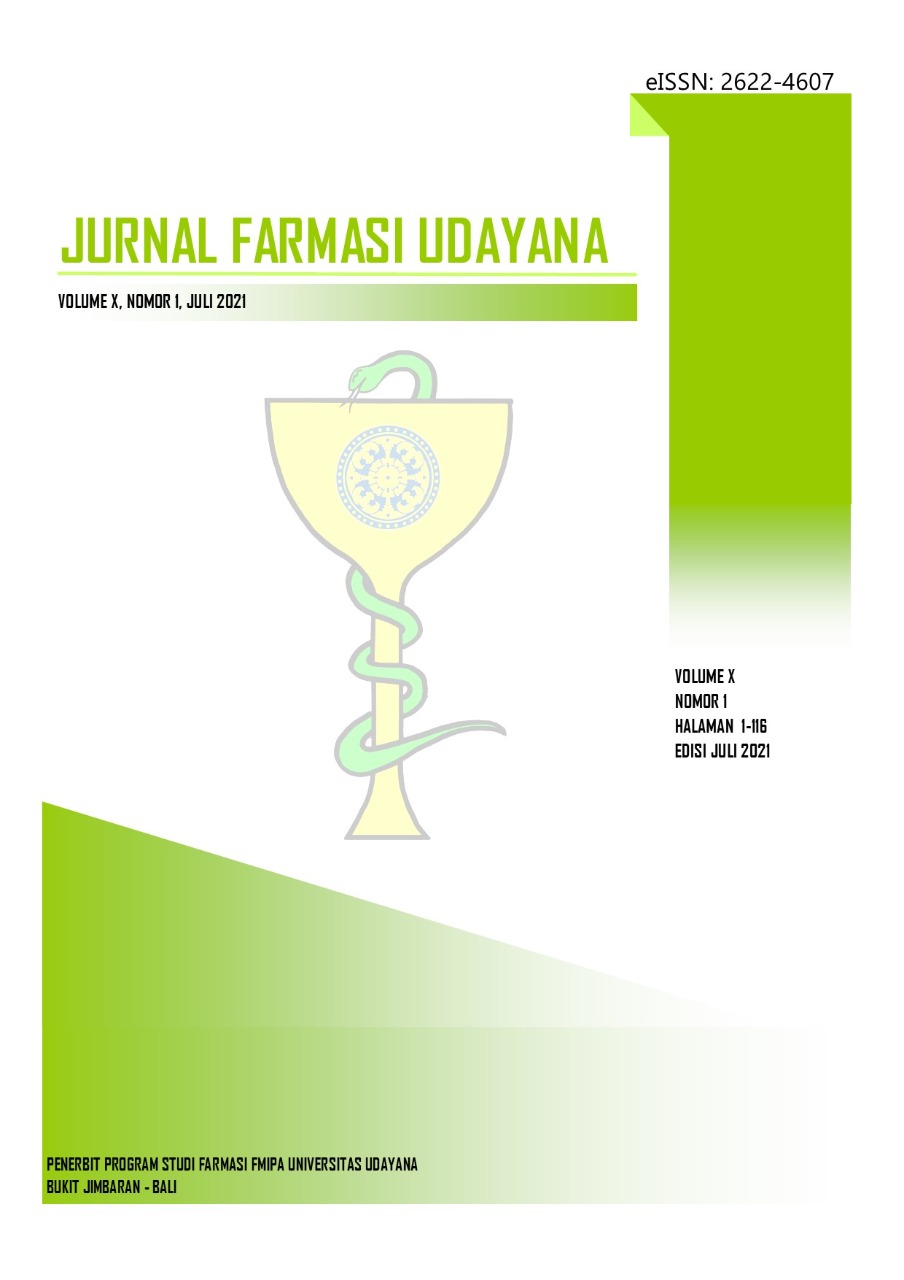Pengaruh Variasi Metode Ekstraksi Terhadap Perolehan Senyawa Antioksidan Pada Daun Katuk (Sauropus androgynus (L.) Merr)
Abstract
S. androgynus (Phyllanthaceae) contains natural antioxidant compounds such as phenolics and flavonoid derivatives. The successful to obtain the plant metabolite compounds depends on the extraction method. This study aims to determine the total phenolics and flavonoids content of the ethanolic extract of S. androgynus leaves obtained from three types of extraction methods, namely maceration, Soxhletation, and ultrasonic. Determination of total phenolics and flavonoids content was carried out by colorimetric method using Folin-ciocalteu and AlCl3 10% reagents, respectively. The absorbance of the reaction was measured using a UV-Vis spectrophotometer. Total phenolics content is expressed as equivalent to gallic acid, while total flavonoid content is expressed as equivalent to quercetin. Determination of the extract's antioxidant activity was carried out against DPPH free radical and expressed by the IC50 (ppm) value. The results showed that the ultrasonic extraction method produced the best levels of phenolics (42.96 ± 0.51 mgGAE/g), flavonoids (12.05 ± 0.36 mgQE/g) and antioxidant activity (IC50 = 81.43 ± 2.63 ppm) in ethanolic extract of S. androgynus leaves compared to another extraction method (maceration > Soxhletation). Thus, it can be concluded that the ultrasonic extraction method is an efficient and effective extraction method to produce high antioxidant compounds in ethanolic extract of S. androgynus leaves.
Downloads
References
Andarwulan, N., Batari, R., Sandrasari, D. A., Bolling, B., & Wijaya, H. (2010). Flavonoid content and antioxidant activity of vegetables from Indonesia. Food Chemistry, 121(4), 1231–1235.
Andini, D. (2014). Potential Of Katuk Leaf (Sauropus androgynus L. Merr) As Aphrodisiac. Journal Majority, 3(7), 16–21.
Arceusz, A., Wesolowski, M., & Konieczynski, P. (2013). Methods for Extraction and Determination of Phenolic Acids in Medicinal Plants : A Review. Natural Product Communications, 8(12), 1821–1829.
Azmir, J., Zaidul, I. S. M., Rahman, M. M., Sharif, K. M., Mohamed, A., Sahena, F., … Omar, A. K. M. (2013). Techniques for extraction of bioactive compounds from plant materials: A review. Journal of Food Engineering, 117(4), 426–436.
Azwanida, N. N. (2015). Review on the Extraction Methods Use in Medicinal Plants, Principle, Strength and Limitation. Medicinal and Aromatic Plants, 4(3), 1–6.
Chang, C.-C. ., Yang, M.-H. ., Wen, H.-M. ., & Chern, J.-C. (2002). Estimation of Total Flavonoid Content in Propolis by Two Complementary Colorimetric Methods. Journal of Food and Drug Analysis, 10(3), 178–182.
Dai, J., & Mumper, R. J. (2010). Plant phenolics: Extraction, analysis and their antioxidant and anticancer properties. Molecules, 15(10), 7313–7352.
Departemen Kesehatan RI. (2000). Parameter Standar Umum Ekstrak Tumbuhan (p. 76). p. 76. Jakarta: Ministry of Health, Indonesia.
Djamil, R. ., & Zaidan, S. (2016). Isolasi Senyawa Flavonoid dari Ekstrak Metanol Daun Katuk (Sauropus androgynus (L.) Merr), Euphorbiaceae. Jurnal Ilmu Kefarmasian Indonesia, 14(1), 57–61.
Hanani, E. (2015). Analisis Fitokimia (In Bahasa). Jakarta: Buku Kedokteran EGC.
Hikmawanti, N. P. E., Rusdi, N. K., & Yulida, S. (2020). Evaluation of sperm quality in male rats treated with Sauropus androgynus (L.) Merr. leaf fractions. Pharmaciana, 10(2), 193–200.
Kementerian Kesehatan RI. (2008). Farmakope Herbal Indonesia (FHI) (Ed. 1). Jakarta: Kementerian Kesehatan RI.
Khoddami, A., Wilkes, M. A., & Roberts, T. H. (2013). Techniques for analysis of plant phenolic compounds. Molecules, 18(2), 2328–2375.
Khoo, H. E., Azlan, A., & Ismail, A. (2015). Sauropus androgynus Leaves for Health Benefits: Hype and the Science. The Natural Products Journal, 5, 115–123.
Moharram, H. A. ., & Youssef, M. M. (2014). Methods for Determining the Antioxidant Activity : A Review. Alexandria Journal of Food Science and Technology, 11(1), 31–42.
Nijveldt, R. J., Van Nood, E., Van Hoorn, D. E. C., Boelens, P. G., Van Norren, K., & Van Leeuwen, P. A. M. (2001). Flavonoids: A review of probable mechanisms of action and potential applications. The American Journal of Clinical Nutrition, 74, 418–425.
Pandey, A., & Tripathi, S. (2014). Concept of standardization, extraction and pre phytochemical screening strategies for herbal drug. Journal of Pharmacognosy and Phytochemistry, 2(5), 115–119.
Patonah, Susilawati, E., & Riduan, A. (2017). Aktivitas Antiobesitas Ekstrak Daun Katuk (Sauropus androgynus L. Merr) Pada Model Mencit Obesitas. Pharmacy, 14(02), 137–152.
Petrus, A. J. A. (2013). Sauropus androgynus (L.) Merrill - a potentially nutritive functional leafy-vegetable. Asian Journal of Chemistry, 25(17), 9425–9433.
Quideau, S., Deffieux, D., Douat-casassus, C., & Pouysøgu, L. (2011). Natural Products Plant Polyphenols : Chemical Properties , Biological Activities , and Synthesis **. Angew. Chem. Int., 50, 586–621.
Rusdi, N. K., Hikmawanti, N. P. E., Maifitrianti., Ulfah, Y. S., & Annisa, A. T. (2018). Aktivitas Afrodisiaka Fraksi dari Ekstrak Etanol 70% Daun Katuk (Sauropus androgynus (L.) Merr) Pada Tikus Putih Jantan. Pharmaceutical Sciences and Research (PSR), 5(3), 123–132.
Singh, S., & Singh, R. P. (2008). In vitro methods of assay of antioxidants: An overview. Food Reviews International, 24(4), 392–415.
Stalikas, C. D. (2007). Extraction, separation, and detection methods for phenolic acids and flavonoids. J. Sep. Sci., 30, 3268–3295.
Wan, C., Yu, Y., Zhou, S., Liu, W., Tian, S., & Cao, S. (2011). Antioxidant activity and free radical-scavenging capacity of Gynura divaricata leaf extracts at different temperatures. Pharmacognosy Magazine, 7(25), 40–45.
Watson, R. R. (Ed.). (2019). Polyphenols in Plants: Isolation, Purification and Extract Preparation (2nd ed.). London: Academic Press Elsevier.
Wijono, S. H. (2004). Isolasi dan Identifikasi Asam Fenolat pada Daun Katu (Sauropus androgynus (L.) Merr). Makara, Kesehatan, 8(1), 32–36.
World Health Organization. (1998). Quality control methods for medicinal plant materials. Geneva, Switzerland: World Health Organization.
Yang, J., Paulino, R., Janke-Stedronsky, S., & Abawi, F. (2007). Free-radical-scavenging activity and total phenols of noni (Morinda citrifolia L.) juice and powder in processing and storage. Food Chemistry, 102(1), 302–308.




